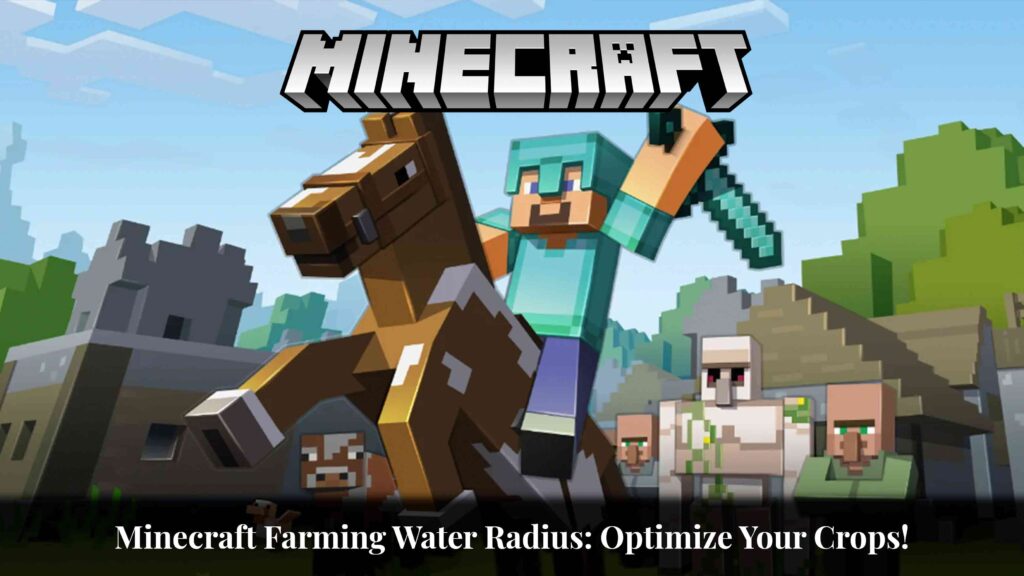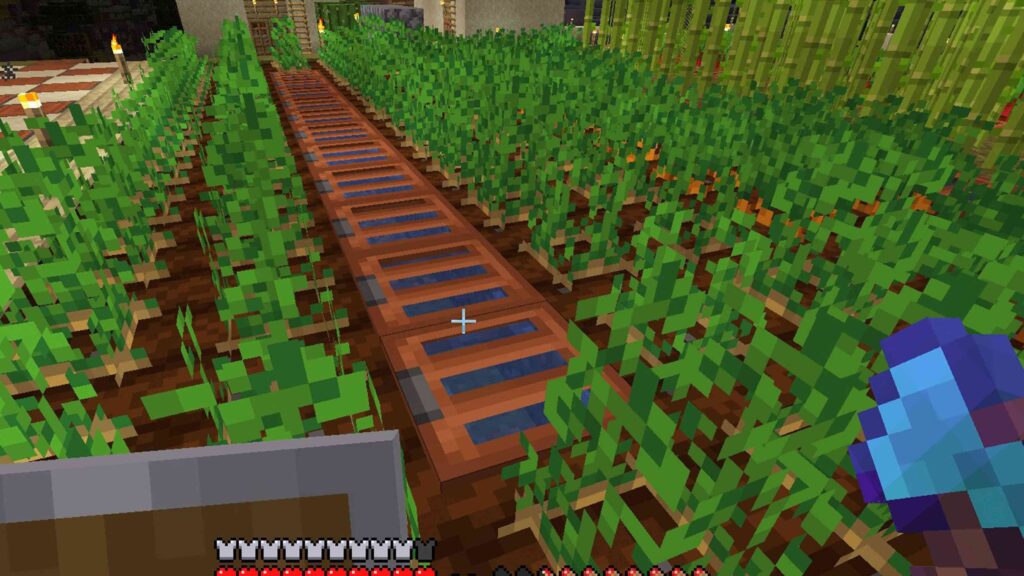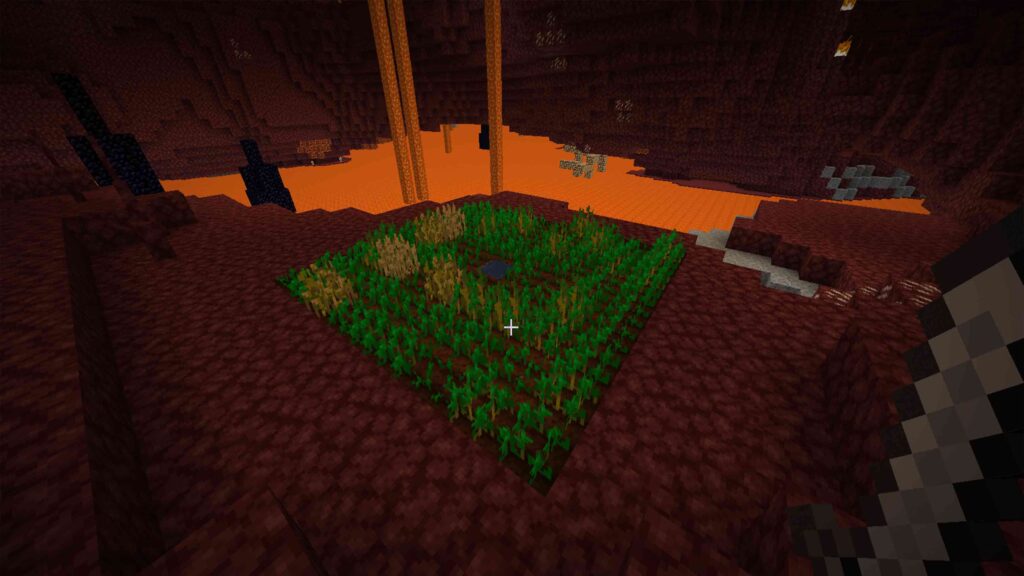Introduction
Hello, fellow Minecraft enthusiasts! When it comes to farming in Minecraft, understanding the concept of water radius is vital. Just like in the real world, water plays a pivotal role in the game. Today, we’ll delve deep into the mechanics of water radius, its benefits, and how to leverage it for optimized crop yields.
What is Water Radius and How Does It Work?
Water radius isn’t just a fancy term. In Minecraft, each water block can hydrate farmland up to four tiles away, in every direction. That’s our water radius. When the farmland block is hydrated, crops grow faster. To understand this, imagine a water block at the center of a 9×9 square. All those tiles, 4 on each side, benefit from the water.
The Concept of Water Radius
Water radius is the horizontal distance from a water source block that can hydrate farmland blocks. A water source block is a block of water that does not flow or move. A farmland block is a dirt block that has been tilled with a hoe and can support crop growth. A hydrated farmland block is a farmland block that has been moistened by a water source block within the water radius.
The default water radius in Minecraft is 4 blocks, meaning that a water source block can hydrate farmland blocks within a 9×9 square area around it. This means that you can have up to 80 farmland blocks hydrated by one water source block. However, this does not mean that you can place your water source block anywhere within the 9×9 area and expect the same results. The water radius is calculated by adding the absolute values of the horizontal differences between the coordinates of the water source block and the farmland block. For example, if your water source block has the coordinates (0, 0) and your farmland block has the coordinates (3, -2), then the water radius is |0 – 3| + |0 – (-2)| = 3 + 2 = 5. This means that the farmland block is within the water radius and will be hydrated by the water source block.
Mechanics of Minecraft’s Water Radius
Minecraft’s vast universe contains a myriad of mechanics, and among the most intriguing is the water radius. It’s a cornerstone for farmers aiming for lush, fruitful crops. Let’s dive into its mechanics.
In Minecraft, a single water block possesses the ability to hydrate farmland up to four tiles away in every direction. This results in a hydration field encompassing a 9×9 square with the water block centered. But why is this vital?
Hydrated farmland, distinguishable by its darker hue, promotes faster and healthier crop growth compared to its dry counterpart. When crops like wheat, carrots, or potatoes are planted on these darker patches, the chances of a bountiful harvest skyrocket.
Yet, there’s more than just placing water. The game checks for water within its hydrating range in a sporadic pattern, ensuring random tile hydration. The mechanic is ingenious in its simplicity and provides a strategic depth to farming.
Benefits of Proper Water Radius Utilization
Water radius is important for farming in Minecraft because it affects crop growth speed and hydration. Crops grow faster when they are hydrated by a water source block within the water radius. Hydrated crops also have a higher chance of dropping more seeds when harvested. Hydrated farmland blocks also do not revert to dirt blocks when jumped on or walked over by mobs or players.
Using water radius properly can help you optimize your farming efficiency and productivity. You can design your farming layout to maximize the number of farmland blocks hydrated by one water source block. You can also use different types of blocks to create aesthetic and functional farming designs that utilize water radius. It create challenging and fun farming scenarios that limit or modify the water radius and require careful planning and management.
Tools and Techniques to Measure Water Radius
Measuring water radius in your world can help you plan your farming layout and optimize your crop growth. There are several tools and techniques that you can use to measure water radius in Minecraft:
• Debug Screen: The debug screen (F3) is a feature that displays various information about your game and your world. You can use it to find the coordinates of your water source block and your farmland blocks. To open the debug screen, press F3 on your keyboard. To close it, press F3 again or Esc.
• Formula: You can use the formula water_radius = abs(x1 – x2) + abs(z1 – z2) to calculate the water radius, where (x1, z1) are the coordinates of the water source block and (x2, z2) are the coordinates of the farmland block. You can use a calculator or a spreadsheet to do the calculations. For example, if your water source block has the coordinates (10, 20) and your farmland block has the coordinates (15, 25), then the water radius is |10 – 15| + |20 – 25| = 5 + 5 = 10. This means that the farmland block is outside the water radius and will not be hydrated by the water source block.
• Visual Cues: You can also use visual cues to estimate the water radius in your world. You can look at the color and texture of the farmland blocks to see if they are hydrated or not. Hydrated farmland blocks are darker and smoother than dry farmland blocks. You can also look at the crop growth stages to see if they are growing faster or slower. Hydrated crops grow faster and have more leaves than dry crops.
Advanced Farming Techniques and Water Radius
Water radius is not only a factor that affects crop growth and hydration, but also a tool that you can use to create advanced farming techniques and methods. Here are some of the advanced farming techniques that use water radius in Minecraft:
• Vertical Farming: Vertical farming is a technique that involves stacking multiple layers of farmland blocks on top of each other and hydrating them with water source blocks placed in strategic locations. This technique allows you to save space and increase your crop yield per unit area. However, it also requires more resources and maintenance, as you need to build structures to support the layers and prevent them from collapsing or being destroyed by mobs or players.
• Diagonal Farming: Diagonal farming is a technique that involves placing farmland blocks in a diagonal pattern and hydrating them with water source blocks placed in the corners. This technique allows you to maximize the number of farmland blocks hydrated by one water source block, as you can have up to 104 farmland blocks hydrated by one water source block. However, it also requires more precision and planning, as you need to align the coordinates of the water source block and the farmland blocks correctly.
How to Modify Water Radius with Mods and Commands
Mastering Minecraft means tweaking its core elements. One such element, crucial for farming, is the water radius. But can you modify it? Absolutely.
Mods: Several user-friendly mods allow players to adjust the water radius in Minecraft. Some popular choices include “Farming Extended” and “Hydration Tweaker.” Simply download your chosen mod, install it, and access its settings. Adjust the water radius as you see fit, ensuring your farmland remains optimally hydrated.
Commands: For those who prefer the command route, use the “/gamerule” command. Though not directly modifying the water radius, manipulating game rules can influence hydration levels and crop growth rates. Example: “/gamerule randomTickSpeed 50” increases block updates, indirectly affecting crop hydration.
Specific Crops and Their Water Needs
Different crops, different needs. Wheat, carrots, and potatoes, for instance, have varying water requirements. It’s essential to understand these to optimize your farm.
How to Minimize Water Radius for Your Farming Challenges
In the pixelated realm of Minecraft, efficient farming can sometimes pose challenges, especially concerning water radius. How, then, can you minimize this radius without compromising crop growth?
Strategic Placement: Instead of scattered water sources, use central water blocks. By positioning a single water source in the midst of a 9×9 farmland grid, you can hydrate all surrounding blocks within a four-tile radius, optimizing space.
Utilize Slabs and Pressure Plates: By placing non-full blocks like slabs or pressure plates next to water sources, you can maintain a walkway without falling into water. This ensures accessibility while retaining a compact design.
Vertical Farming: Embrace height! Create tiered farms, where each level has its own water source. This minimizes horizontal spread, using vertical space instead.
Redstone Magic: For the tech-savvy, consider Redstone-powered water dispensers. Deploy water when needed and retract to save space.
Case Studies: Successful Farm Designs
Water radius is an important factor for farming in Minecraft, but it is not the only one. There are many other factors that affect your farming success, such as light, soil, biome, layout, design, etc. Here are some examples of successful farm designs that use water radius and other factors effectively:
• The Spiral Farm: This farm design uses a spiral shape to maximize the number of farmland blocks hydrated by one water source block. The water source block is placed in the center of the spiral and hydrates the farmland blocks that are arranged in a circular pattern around it. The spiral shape also allows for easy access and harvesting of the crops, as well as a pleasing aesthetic.
• The Checkerboard Farm: This farm design uses a checkerboard pattern to alternate between farmland blocks and water source blocks. The water source blocks hydrate the farmland blocks that are adjacent to them, creating a grid of hydrated farmland blocks. The checkerboard pattern also allows for efficient use of space and resources, as well as a simple and elegant design.
Challenges and Solutions
Mastering farming in Minecraft isn’t just about sowing seeds; it’s understanding the intricacies of water radius. However, like any gameplay mechanic, challenges arise. But fret not, solutions are at hand.
Challenge 1: Inconsistent Hydration
In larger farms, some farmland blocks remain dry, leading to uneven crop growth.
Solution: Ensure your water source covers a 9×9 grid. Place water strategically, maintaining a four-block distance, to guarantee consistent hydration.
Challenge 2: Hot Biomes
Biomes like deserts can play havoc with water sources, making them evaporate.
Solution: Use non-evaporative blocks like leaves or lily pads to cover water, ensuring hydration without evaporation.
Challenge 3: Accessibility
Farms filled with water can hinder movement, making crop maintenance cumbersome.
Solution: Incorporate half-blocks like slabs, or use pressure plates around water sources. They allow easy walkability while ensuring water’s presence.
Water Radius in Aquatic Update
Water radius is a game mechanic that has been changed and improved in the Aquatic Update, which is an update that adds new features and content related to water and oceans in Minecraft. Here are some of the changes and improvements related to water radius in the Aquatic Update:
• Water Physics: Water physics have been revamped and enhanced in the Aquatic Update, making water more realistic and dynamic. Water now flows through gaps and holes, fills empty spaces, and forms bubbles and currents. Water also interacts with different types of blocks differently, such as coral, kelp, seagrass, etc.
Sustainability in Minecraft Farming
Water radius is a game mechanic that can affect the sustainability of your farming in Minecraft. Sustainability is the ability to maintain or improve your farming without compromising its quality or quantity. Sustainability is important for farming in Minecraft because it can help you conserve your resources, protect your environment, and enhance your gameplay experience. Here are some tips and tricks for improving your sustainability in Minecraft farming:
• Use Renewable Resources: Renewable resources are resources that can be replenished or regenerated over time. Renewable resources are preferable for farming in Minecraft because they can help you reduce your waste and consumption. Some examples of renewable resources for farming in Minecraft are:
• Water: Water is a renewable resource that can be obtained from various sources, such as rain, rivers, lakes, oceans, etc. Water can also be created by placing two water source blocks next to each other or by using an infinite water source.
Conclusion
Congratulations! You now have a solid understanding of the water radius for farming in Minecraft. By strategically placing water sources and ensuring proper hydration, you can maximize crop growth and yield. Remember, each block of farmland can be hydrated by a water source within a four-block radius horizontally and one block vertically. This means that you can efficiently irrigate large areas of farmland with just a few well-placed water sources.
Now that you have the knowledge to optimize your Minecraft farming techniques, it’s time to put it into practice. Experiment with different crop placements, irrigation strategies, and water source locations to find what works best for your farm. Don’t be afraid to get creative and think outside the box – after all, the possibilities in Minecraft are endless!
FAQs
- Q: How does elevation impact water radius?
A: Elevation can restrict water flow, potentially reducing hydration levels for farmland. - Q: Can I use rain as my sole water source for farming?
A: No. Rain can moisten farmland, but water blocks are vital for consistent hydration. - Q: Are there mods to auto-calculate water radius for me?
A: Yes, several mods can help with this, enhancing your farming experience. - Q: How often does water need to be adjacent to farmland for optimal growth?
A: Ideally, a water block should be within 4 tiles of farmland for best growth. - Q: Do different crops have different water radius needs?
A: All crops benefit from proper hydration, but specific needs can vary. Always research your chosen crop.









